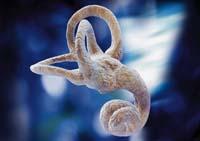Cochlea, low-frequency sound amplifier

As if it were a microphone, the inner ear converts sounds into electrical signals so that neurons transport the signal to the brain. The cochlea, a spiral-shaped organ, converts sound into an electrical signal. Scientists have wanted to find out why the coin looks like this and have found that the spiral amplifies low-frequency sounds, ears of the human ear.
The sound reaches the inner ear by vibrating the eardrum and receives the basic membranes, a membrane that divides the inside of the elbow into two. This membrane is extended from one end to the other of the cocktail and is a spiral like the cochlea itself. For that reason, scientists wanted to know why it is better than a vibration transmission membrane out of a spiral.
They took into account that the transmission is made from the membrane to a liquid, so they studied the physics of interaction between both elements. When spiral, the vibration inclines the membrane more outward than inward, and this system better amplifies the low-frequency sounds than the high-frequency ones. In the case of the human being, the signal increases by 20 decibels to these frequencies.
Scientists are studying in other mammals in which the same occurs, since many mammals listen to these frequencies. In short, the lower the frequency of sound, the farther it reaches.






